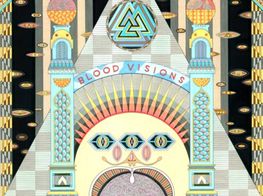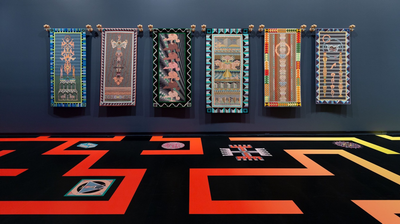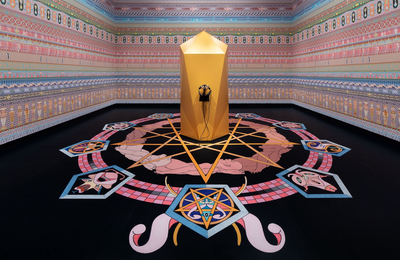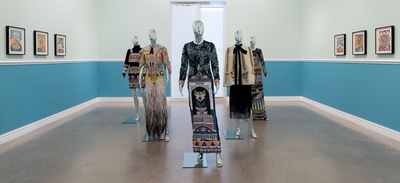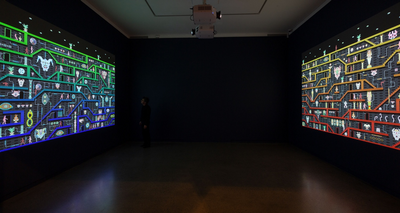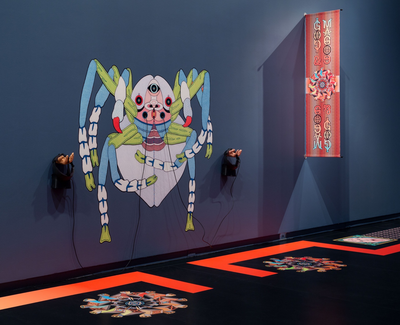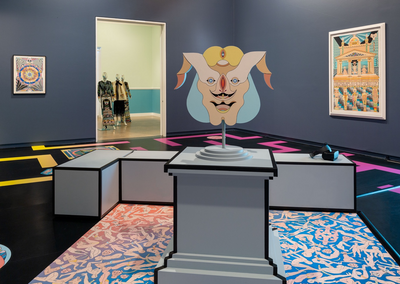Jess Johnson: Worlds Within Worlds
Jess Johnson. At the McCahon House Residency, Titirangi, New Zealand, February 2019. Photo: Rebekah Robinson.

Jess Johnson. At the McCahon House Residency, Titirangi, New Zealand, February 2019. Photo: Rebekah Robinson.
Geometric patterns, anthropomorphic characters, architectural spatial environments, and relics of the ancient world appear throughout Jess Johnson's artworks.
Johnson's solo art-ventures began in drawing, but her long-term collaborative relationship with animator Simon Ward brings her drawings to life in videos and virtual reality. The animator has been able to give time, and linear narrative to Johnson's still worlds that hover in their own speculative future, shaping both artists' individual practices.
These artworks offer complete escapism and invite the viewer into hypnotic realms where virtual worlds are represented in hyper-detailed drawings and immersive installations—like in Wurm Haus (2015), which features worms drifting in and out of voids, orifices, and black holes. First exhibited at the National Gallery of Victoria, the installation took shape with Johnson's drawings and the V.R. artwork Ixian Gate (2015). The animation used Oculus Rift technology to provide the audience with 360-degree views of Johnson and Ward's parallel universes. Inspired by Frank Herbert's 1965 science-fiction novel Dune, the artwork reflects on machine culture and futuristic ideologies of technology—while creating an immersive space that begins with the installation in the gallery.
Johnson's art practice began early, growing up in a rural beach town, in Tauranga, New Zealand. This quiet upbringing, in the pre-internet years, meant the artist grew up conjuring her fantasy worlds. The covers of VHS and sci-fi books at second-hand bookstores gave the artist her first sources of inspiration. With a similar backstory for Ward, the duo have paved their own careers in the advancement of technology and art, exploring expanding digital worlds.
In 2018, the National Gallery of Australia (NGA) commissioned Terminus, an exhibition that brings V.R., expansive installation, and drawings together—including works like Tumblewych (2018), which contains graphic comic aesthetics using fibre-tip pen, fibre-tip markers, and gouache in bright techy colours, optical illusions, and mystic characters looking down on an altar of sorts. The five sets of V.R. present a puzzle of sensory overload, 'complete with a mysterious universe of alien architecture populated by humanoid clones and cryptic symbols, explored via a network of travellators and gateways.' The NGA is now touring the intricate, systematic work, with its first stop at the Heide Museum of Modern Art, Melbourne, where it is showing until 1 March 2020.
In this conversation, Johnson discusses her exhibition at the Heide Museum of Modern Art and her exhibition debut in Japan with Neon Meat Demon at NANZUKA in Tokyo (23 November–22 December 2019). Both exhibitions explore the virtual worlds that slip into video game aesthetics and ancient languages, all while exploring the depth of our realities, in their malleable and multiple nuances.
EKWThe show at Heide Museum of Modern Art, Melbourne is based around Terminus, the virtual reality artwork and videos produced with Simon Ward, your long-time collaborator. Also included are a series of quilts made in conjunction with your mother, and the fashion collaboration with Romance is Born for their 2016 Spring/Summer Collection titled Mysteria Wisteria.
I'm intrigued by the series of quilts that you've made with your mother. How did you end up making these works?
JJMy mother and I started the quilt collaboration in 2018, at the tail end of finishing Terminus; Simon and I worked on Terminus very intensely for about a year. I felt a little bit... not burnt out, but I didn't want to be anywhere near V.R. for a while after that [laughs]. Beginning the quilt project with my mother was something of a mental reprieve from the intensive digital world that I'd been immersed in with Simon. But also, in the last several years, I'd become aware of the influence that my mother's quilt-making had on my own art practice. Previously, I'd been, not dismissive of it, but I saw it as just something mum did in the background. She's always given us quilts as presents when we reached milestones or moved overseas, and they've become something that I carry with me from house to house or country to country. They'd always represented home and domesticity to me, but when we decided to make quilts together, it came from this dawning realisation that there were many similarities between mum's quilt-making and how I construct my drawing. I was considering her quilts in a new light with much more respect for them as an art form.
There's a lot of geometry and patterning in both the drawings and quilts, and all of these synergies between the methodology and compositions. The process of making the quilts together began by designing and printing material with elements from my drawings from the U.S., where I have my studio, and then I'd send mum these bolts of cloth to New Zealand. She would start piecing the quilts and designing these elaborate borders. We'd go back and forth on Skype about different colours and pattern designs.
EKWHow did the collaborative relationship with Simon begin?
JJWe are both New Zealanders, and as everyone in New Zealand does, we had a lot of mutual friends, and also knew of each other's work. I knew him for the music videos that he made, which had this unique style of weird computer-generated worlds mixed with D.I.Y. effects. And Simon also knew of me through my sci-fi drawings back when I had a solo practice.
Simon was working on the film Avatar in Wellington with one of my oldest best friends, and she introduced us and basically told us we should make stuff together because we both liked each other's work. It was like getting creatively match-made. When Simon moved to Melbourne, he came to visit my Gertrude Street studio, and from the first time we met, we started working together. Our brains work in similar ways; our work ethic is similar too. And we have very comparable reference points in popular culture. It's been very fruitful. All of my drawings now feed into the collaborative work that we do together.
EKWIt's unique to find somebody else who can interpret those visions. Do you find that your practices feed into one another's?
JJYes, definitely. I'm always considering how my drawings will end up animated, and I think my drawings have become more 3D because of it. Simon uses my drawings as the building blocks for the animations. My drawings are like frozen window scenes that peer into that world, but they're unhinged from any timeline or linear narrative. And what Simon does is he connects the dots between the drawings, creating these dreamy 'walkthroughs'. He is much more adept at putting his mind in the mind of the audience and taking them on a narrative visual journey, which he honed from his years of working on music videos.
EKWWhat thematic spaces will Terminus at Heide Museum of Modern Art explore?
JJThe main element of the exhibition is the five-part V.R., Terminus, which was commissioned by the National Gallery of Australia in 2018, and is now being toured around Australasia. The installation has to be reconfigured to fit each gallery, as the V.R. experiences are built around a tessellated floor map and modular structures.
It took a major redesign to adapt it to the Heide space, and Sue Cramer, the curator at Heide, wanted to also show the other facets of my artwork, like the quilts I make with my mother, original drawings, and fashion collaborations. So the show at Heide is much more extensive; they've loaned lots of work to showcase all the different mediums that the drawn imagery morphs into.
EKWIt all seems to flow together, like the worlds within worlds depicted in your drawings. By working with V.R., you've created a way for people to completely detach from the day-to-day world, and enter into your world.
JJYes. It's complete escapism, virtual reality. I'm much more attracted to complete immersion as opposed to augmented reality. I want to be catapulted to a different planet entirely.
EKWHow did your fashion collaboration come together? Does that feed into the videos as well?
JJNot so much, but one of mine and Simon's long-term goals is to make an animated feature film. In this imaginary film, I've always wanted some interplay between live-action and animation. I've thought about what elaborate costumes my live-action characters might wear, and I got a little taste with the fashion house Romance was Born. I didn't know Luke and Anna from Romance Was Born personally, but I was a big fan of their clothing and owned a few things, like a Marvel Comics tunic with the Silver Surfer on it.
I think they first became aware of my work after I was in Primavera at the Museum of Contemporary Art Australia in 2013. Then a year or so later, I was undertaking a residency at Artspace, Sydney, and they contacted me and asked if we could potentially work on a collaboration. At the time, I was really stretched thin with exhibitions, but still super keen. However, I knew that if I got too involved in the designs, it would be a total time suck and I might try to control things too much, which would hamper their own creative process. And so, I decided to just give them complete free rein. I gave them access to my whole archive of drawings, which was probably about five years' worth. I found it was quite elating to give that control of the world over to someone else.
EKWWhen I had a look at the collection, I noticed the drawings, but other pieces seemed quite sculptural. It's intriguing how the artworks blend into the fashion collaboration.
JJSome of the fashion pieces in the show are elaborate couture gowns, which include sequinned alien heads with voided worms pouring out of the orifices—the really batshit psychedelic pieces are my favourite from the collection.
Did you find growing up in New Zealand had an influence on your practice?
I think it's the same for me as it was for Simon; we both came from small, rural towns. I grew up in Mount Maunganui, a little beach town, which was pretty undeveloped when I was a kid. There were no buildings over one-storey high, and we went to primary school barefoot. Simon grew up in Napier, and perhaps there wasn't a lot to do in Napier either! A lot of our childhood was about learning to make your own fun. It was pre-internet as well, so a lot of downtime to fill.
We were both into escapism and losing yourself in other worlds. Computers were another world for Simon. He makes his own fun on computers, and for the most part, is self-taught. If you don't know the rules, you can break the rules and create your own pathways. And for me, it was books and film; science fiction and fantasy. I actually got into art through the cover art on record sleeves, VHS tapes, and sci-fi books at second-hand bookstores.
EKWAnd now we see the digital has managed to catch up with this generation of people's imaginations.
JJYeah, that's right. We work so well together because we have such different skill sets, both analogue and digital. The imagery of my drawings is filtered through Simon's imagination and allows the world to keep growing and evolving. All of the different collaborations that I do get filtered through other people's imaginations, and it expands the universe in greater ways from what I can conceive of alone.
EKWI read that your work has been influenced by architecture as well—both Japanese and European.
JJWhen I first travelled overseas, I was really drawn to the super old things in museums—historical artefacts and European architecture—maybe because it was in such contrast to New Zealand, which is a very young country. I was really struck by being able to stand in front of these physical connections to the ancient past.
EKWI noticed that the elements in your work seem to cross over into different time periods. They have the contemporary and highly digitised elements, but also, the videos look like ancient Egyptian hieroglyphics that have been brought to life. The artworks seem to cross between these two completely polar opposite times in history.
JJOn the drive to Heide this morning, I was talking to the exhibition manager about Egypt, because her kids are fascinated by Egypt and she saw the same thing in my drawings that you mention. We were trying to work out what the attraction was. I think a lot of it is to do with codes and encryption. Egypt was all about secret passageways, tombs, mummies, labyrinths, pyramids—what's not to like? Everyone wants to find the key to unlock the reality underneath our own.
EKWHave you found that your move to New York has changed your practice?
JJReally, everything does. When you go through any significant life change, or even reflecting on what's happening politically, it all seeps in and permeates what you're creating. Perhaps not consciously, but if I look back, I can see shifts in my drawings that may relate to what was happening 'on the outside', thematically or just in tonal moods.
I moved to the United States in 2016, which was a very strange time in the U.S. In the lead-up to the election, I was doing a residency in Nebraska for artists specifically working in themes of science fiction. There was a lot of visible support for Trump surrounding us, and it almost felt like we were right in the belly of the beast, in the centre of America. I was making a lot of work at that time, and then, of course, the election happened, and it felt quite apocalyptic for a while. I can look back at the drawings created during that residency, and while I try to refrain from saying my world is either a utopia or dystopia, the drawings that I was doing at that time feel more 'dense' with power and unease, perhaps leaning towards the dystopic more than any other works I've done.
EKWWhat are the titles of those works?
JJThere was one called Total War [laughs]. But also, the spatial restrictions of New York studios have changed my practice. Studio spaces are so expensive in New York. My current studio is a little basement in Chinatown. It's a struggle to make bigger, or more expansive works when you're in a little basement dungeon. That's why I try to do a lot of residencies, in order to have a nicer workspace and to get time away from New York. The city can be horribly distracting. New York is a good place for stimulation, but not necessarily for being productive. I often say I feel like a hamster on a wheel when I'm in New York; I'm constantly busy and breathless, but the productivity doesn't reflect that.
EKWDo you anticipate staying in New York?
JJHaving gallery representation in New York makes it a lot more feasible to survive there as an artist. I plan to stay there for as long as I've got the energy for it. But also, I do get a lot of time away from New York through travel for shows and residencies. I think having time away from New York is essential to retain my perspective and sanity. I like doing residencies that are totally remote and isolated, to have that contrast to the city. I also go back to New Zealand quite a bit to visit family.
EKWI know you did a residency in Japan in 2013—how was that experience?
JJIt was a slightly odd time as I had a lot of exhibition commitments in Australia, so I was working really long hours in the studio and spending a lot of time alone. Perhaps I had the quintessential Tokyo experience, which was a little surreal and isolating. I had a studio at this place called Tokyo Wonder Site, which sounds colourful and fun but was actually housed in a sterile office-type skyscraper. I had a little single room sleeping cubicle somewhere many floors up, and a studio a few floors below. I'd look out my window, and all I could see were other skyscrapers and people working in cubicles, and I remember one day when I was feeling a little crazy I tried to look around my whole view and see if I could see any patch of green and I couldn't, it was all buildings. All grey. Everyone living very solitary cubicle lives, and I was doing the same. I'd go down to the ground floor to the convenience store, Konbini, to get a bento box for dinner and go back up to my room to eat and days would go by when I didn't leave the building.
EKWDid you find any Japanese art-influences?
JJYes, I found a few Japanese artists that I got really into. One of them was Keiichi Tanaami, and the other was Tadanori Yokoo—both of them are massive superstars in Japan. Both artists were very prolific in the 1960s and 70s, and they produced a lot of artwork and posters for the Japanese counterculture. Their work was really graphic and experimented with collage and super bold compositions. Keiichi Tanaami had also done a lot of early experimental animations.
EKWAnd now you'll be heading to Japan to open a show at NANZUKA in Tokyo?
JJYes, during my 2013 residency, I actually visited NANZUKA to see an exhibition of Keiichi Tanaami's work from the 1970s—it was one of my favourite gallery experiences while I was in Japan. So it seemed very serendipitous that I was eventually introduced to Shinji Nanzuka in New York by one of my collectors who thought Shinji might like my artwork. Shinji was very responsive and invited me to do a show with him.
EKWWill it be similar to the show at Heide Museum of Modern Art?
JJShinji was interested in all the different mediums I work in and was willing to invest quite a bit in the exhibition, so it's going to be quite a large installation build. We are doing vinyl flooring, wallpaper, and building structures. We're showing the V.R., some new quilts that I've made with my mother, drawings, and some other animations that I made with Simon. It's quite an involved show for a commercial gallery. —[O]

